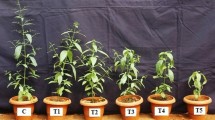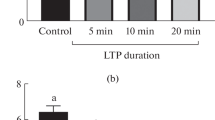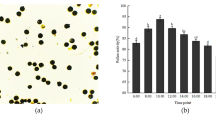Abstract
The effects of Triton X-100 (TX-100) on seed germination, pollen sterility manifestation, number of chloroplasts in stomata guard cells and the viability in sugarbeet (Beta vulgaris L.) were studied. It is was found that TX-100 decelerated seed germination of sugarbeet, changed pollen sterility manifestation, affected chloroplasts number in stomata guard cells and decreased the viability of sugarbeet seeds. The results of the present study indicated that detergent TX-100 may be considered as an epimutagene capable of changing plant genome functioning.
Similar content being viewed by others
Avoid common mistakes on your manuscript.
Immense attention of researchers on epigenetics makes it important to search for substances that induce epigenetic variability. Currently, 5-azacytidine is the most known epimutagene causing DNA chromosome demethylation and, as a consequence of this, activating earlier methylated genes (Jones 1985; Jablonka and Lamb 1989; Janousek et al. 1996; Maletskaya et al. 2006). Demethylated genes are preserved in a number of generations conditioning stable changes of different morphological traits. Changes in the degree of pollen sterility and also the character of branching in floret-bearing shoots, and manifestation of unianthy and synanthy were found in sugarbeet plant treated with 5-azacytidine (Maletskaya et al. 2002). It was also shown that 5-azacytidine decreased a number of cell organelles, chloroplasts in stomata guard cells in sugarbeet plants (Maletskaya et al. 2002). However, alongside with 5-azacytadine that modifies nucleotides in the DNA molecule, there is a principally new type of epimutagene which affects not DNA but the interaction process of DNA with nuclear membrane and nuclear matrix. Non-polar detergent Triton X-100 capable of aberrating protein-membrane bonds could be of such a substance.
It was revealed that TX-100 initiates the inherited changes of morphological traits when wheat and sugar beet seeds are treated with it during their germination (Makhmudova et al. 2009; Kirikovich and Levites 2009a, b). Moreover, it was revealed in these experiments that the effect of TX-100 decreased plant viability. Therefore, it was interesting to compare plants viability and the expression of morpho-physiological traits with the plant cell genome statement estimated on chloroplasts number. It is known that chloroplasts number correlates with the plant genome size and plant ploidy level (Savitsky 1966; Yudanova et al. 2002; Yuan et al. 2009). So measuring of chloroplasts number in plant cells gives the integral information about its genome statement.
The aim of the present research was to study the effect of epimutagene TX-100 on seed germination, pollen fertility manifestation, chloroplasts number in stomata guard cells and the viability of sugarbeet seeds.
Seeds obtained by self-reproduction of agamospermous sugarbeet plants under laboratory number 8-3 were used. Control seeds were soaked in Petri dishes in a thermostat at 29 °C. Experimental seeds were soaked in the 0.1 % TX-100 during 18 h at 29 °C. Then they were washed in the streaming water and placed into the thermostat again. Thus, control and experimental seeds were germinated at the same temperature and humidity. Shoots were planted in the hydroponic greenhouse under lightening 5,000–10,000 lx during 16 h a day with mineral nutrition.
To calculate the chloroplasts number in stomata guard cells from the leaves, plants of the first (field, August, 2008) and the second years (field, August, 2009) of vegetation were used. For preparations epidermis was taken from the basal side of leaves and the chloroplasts were stained with nitrogenous silver (AgNO3) solution. Chloroplasts of 40–70 cells were counted on each slide.
Plant pollen sterility-fertility cytoanalysis was arranged in blooming period (27 July, 2009) with preliminary carmine-treated pollen.
Viability was estimated on the number of living plants during 5 periods. The first period (I) includes the time from the soaking to germination; the second period (II)—the time from shoots planting in the greenhouse (31st of March, 2008) to its replanting in the field (11th of June, 2008). The third period (III) includes the time of vegetation in the field (June–October, 2008); the fourth period (IV)—the time of vernalization (October, 2008–May, 2009) and the fifth period (V)—the time of the second vegetation in the field (May–August, 2009).
Significances in germination differences, fertile-sterile pollen ratio and the viability of control and experimental plants were found using G test (Weber 1986). Statistical analysis for each control and experimental stomata guard cell populations was carried out using t-distribution (Sokal and Rohlf 1995).
It was found that TX-100 affects seed germination process. Thus, 133 untreated seeds (44.3 %) out of 300 from sugarbeet plant no. 8-3 (8-3c) germinated, and 355 seeds (69.6 %) germinated out of 510 seeds of the same plant treated with TX-100 (8-3tr) (Table 1). G test analysis showed the significance in differences between the control and treated seeds at the first period (I) (G = 13.312). It was revealed that TX-100 significantly stimulates germination and viability this period (P < 0.001) (Table 1).
Differences were observed not only in the number of germinated seeds but also in their germination dynamics (Fig. 1).
As is seen from Fig. 1, the seeds 8-3tr germination duration was 5 days longer than that of 8-3c, germination peak being on the 7th day in experimental seeds, whereas it was on the 2nd day in control. Prolongation of experimental seed germination is suggestive of the thing that TX-100 weakens germination energy, whereas germination ability in the seeds of this genotype becomes higher. Longer germination terms indicated that TX-100 may changed plant genome functioning.
Comparison of viability of control and experimental plants during different periods of vegetation is given in Table 1. Viability of treated shoots after planting in greenhouse significantly decreased: 102 (76.7 %) out of 133 planting control plants and 199 (56.1 %) out of 355 planting treated plants gave well-developed roots; differences between control and experimental plants are significant (P < 0.05) (Table 1). No differences in viability between control and experimental plants were revealed during the next period of the first year of vegetation (III) and vernalization (IV) (Table 1).
However, the differences in viability were revealed in the second year of vegetation (period V) (P < 0.01) (Table 1). This supports conclusions that differences between control and experimental groups of plants may be observed not only at the initial, but also at later developmental stages separated by a big time span from the moment of TX-100 treatment and by a big number of cell generations. The high loss of treated plants points to the fact that TX-100 leads to the change of genome functioning and decreases plant viability.
In this connection, it is interesting to study some traits of these plants characterizing genome statement. The chloroplasts number in the stomata guard cells are concerned as those integral characteristics. It is known that this trait correlates with plant genome size and ploidy level (Savitsky 1966; Yudanova et al. 2002; Yuan et al. 2009). In Tables 2 and 3 the chloroplasts number in stomata guard cells of control and treated plants are compared. It was shown that vernalization leads to the evidence of an increasing chloroplasts number in both groups of plants (Table 2).
Distinct differences were revealed in the number of chloroplasts between control and experimental plants for the first year of vegetation (Table 3). However, no differences were revealed in the viability between control and treated plants during this period (III) (Table 1). Significant differences in viability were revealed between control and experimental plants during the second year of vegetation (period V) (Table 1). However, they had equal number of chloroplasts (Table 3).
These results can be explained by the fact that TX-100 induced changes conserve under normal plant viability, but at the critical period of ontogenesis, such as the reproductive period (V) (Table 1), plants carrying arising changes die and plants similar with control survive. This fact supports Darwin`s conclusions on the point that natural selection keeps organisms corresponding to the environment (Darwin 1868).
However, for some changes of traits, which were not considerably affected by natural selection, there is still a possibility to survive even after a considerable death of part of sample. Pollen fertility turned to be such a trait.
Control and experimental plants were, in some extent, sterile, but treated plants had more fertility than control plants (G = 26.3597; P < 0.001), (Table 4). Thus, TX-100 increased pollen fertility in this plant form. Validity of differences was revealed in big samplings of pollen grains: 8-3c 5604 (p. g.) from 28 plants and 8-3tr 4508 (p. g.) from 23 plants (Table 4). It indicates that TX-100 effectively changes physiological processes in treated plants.
The obtained data proved that detergent Triton X-100 affects plant genome function changing DNA chromosome interaction with the nuclear membrane and nuclear matrix. As these changes are observed not only at the initial developmental stages, but also during blooming which is separated from the germination stage by a big span of time and a large number of cell generations, it is possible to hypothesize that, on membranes, there are certain sites carrying the information on interaction with chromosomes, and they are capable of not only changing under Triton X-100 treatment but also preserving this changed state in a number of cell divisions.
Thus, the obtained data are indicative of the thing that Triton X-100 may also be considered as an epimutagene. Moreover, they are in favour of the suggested model for multidimensional inherited information coding (Levites 2003, 2005) whose important point is chromosome interaction with the nuclear membrane and nuclear matrix.
References
Darwin, Ch. 1868. The variation of animals and plant under domestication, 1. London: John Murray.
Jablonka, E., and M.J. Lamb. 1989. The inheritance of acquired epigenetic variations. Journal of Theoretical Biology 139: 69–83.
Janousek, B., J. Siroky, and B. Vyskot. 1996. Epigenetic control of sexual phenotype in dioecious plant, Melandrium album. Molecular and General Genetics 250: 483–490.
Jones, P.A. 1985. Alterning gene expression with 5-azacytidine. Cell 40: 485–486.
Kirikovich, S.S., and E.V. Levites. 2009a. Effect of epimutagene Triton X-100 on morphological traits in sugarbeet (Beta vulgaris L.). Sugar Tech 11(3): 307–310.
Kirikovich, S.S., and E.V. Levites. 2009b. Changes in seed germination dynamics and pollen sterility manifestation in sugar beet treated with epimutagene Triton X-100. Innovative potential of young scientists in the development of Siberian agricultural complex, 48–52. Novosibirsk: NSAU. (in Russ).
Levites, E.V. 2003. Theoretical and practical aspects of studies in epigenetic variability in sugarbeet. Sugar Tech 5(4): 209–211.
Levites, E.V. 2005. Sugarbeet plants produced by agamospermy as a model for studying genome structure and function in higher plants. Sugar Tech 7(2&3): 67–70.
Makhmudova, K.Kh., E.D. Bogdanova, and E.V. Levites. 2009. Triton X-100 induces heritable changes of morphological characters in Triticum aestivum L. Russian Journal of Genetics 45(4): 495–498.
Maletskaya, E.I., S.S. Yudanova, and S.I. Maletskii. 2002. Epigenetic and epiplastome variability in apozygotic progenies of sugar beet with 5-azacytidine. Sugar Tech 4(1&2): 52–56.
Maletskaya, E.I., S.S. Yudanova, and S.I. Maletskii. 2006. Effect of the epimutagen 5-azacytidine on the structure of floral-Stalk metameres in sugar beet Beta vulgaris L. Russian Journal of Genetics 42(7): 939–946.
Savitsky, H.I. 1966. Effectiveness of selection for tetraploid plants in Co generation on the basis of the number of chloroplasts in stomata. Journal of the American Society of Sugar Beet Technologists 13(8): 655–661.
Sokal, R.R., and F.J. Rohlf. 1995. Biometry: the principles and practice of statistics in biological research, 937. New York: W.H. Freeman and Co.
Weber, E. 1986. Grundriss der biologischen statistic, 652. Stuttgart: Gustav Fischer Verlag.
Yuan, S.X., Y.M. Liu, Z.Y. Fang, L.M. Yang, M. Zhuang, Y.Y. Zhang, and P.T. Sun. 2009. Study on the relationship between the ploidy level of microspore-derived plants and the number of chloroplast in stomatal guard cells in Brassica oleracea. Agricultural Sciences in China 8(8): 939–946.
Yudanova, S.S., E.I. Maletskaya, and S.I. Maletskii. 2002. Variability of the number of chloroplasts in populations of stomata guard cells in sugar beet Beta vulgaris L. Russian Journal of Genetics 38(1): 58–63.
Acknowledgments
The research was financed with Grant N 99 on the SB RAS Integrative Project for the period of 2009–2011 “Induction of epigenetic changes as a new effective method for developing initial plant breeding forms”. The authors would like to express their gratitude for the English version of this article to Alexander V. Zhuravlev, SB RAS Executive Interpreter.
Author information
Authors and Affiliations
Corresponding author
Rights and permissions
About this article
Cite this article
Levites, E.V., Kirikovich, S.S. Effect of Triton X-100 on the Viability and Morpho-physiological Traits in Sugarbeet. Sugar Tech 16, 442–445 (2014). https://doi.org/10.1007/s12355-013-0289-7
Received:
Accepted:
Published:
Issue Date:
DOI: https://doi.org/10.1007/s12355-013-0289-7





